Space debris is a term for non functional human-made objects like malfunctioned old satellites, pieces of satellites, discarded rocket strapons. Since the start of space age there has been about 5000 launches. The oldest known debris is satellite Vanguard 1 (1958-1964). During the first American spacewalk astronaut Edward White lost his spare thermal glove out of Gemini 4. It stayed in the orbit of the earth traveling around Earth with velocity about 28 000 km/h.
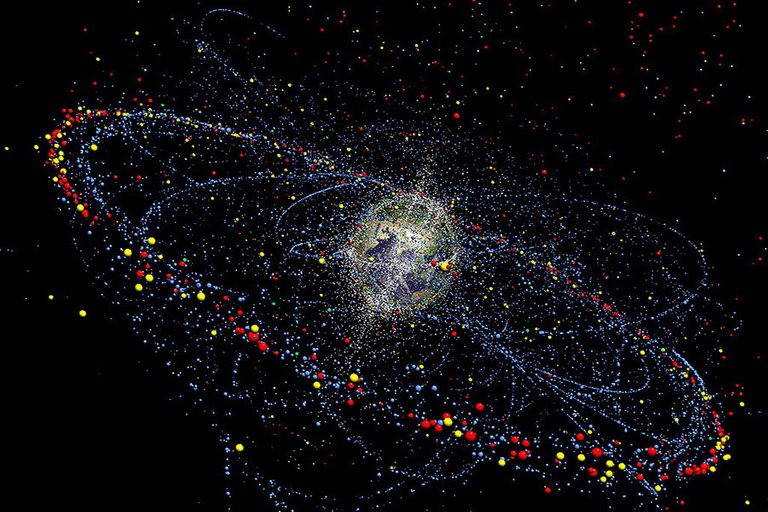
Just as satellites in Low Earth Orbit (LEO), space debris is moving with speeds up to 30 000km/h. The orbits of debris differ in direction, orbital plane, and velocity, however— given enough time collisions are inevitable. With this speed even the smallest pieces of space junk presents a real threat for functional satellites,space stations, and astronauts on spacewalks.
Earth's gravitational pull is ensuring that orbital debris fall back on Earth or burn up in the atmosphere. NASA estimates that one object hits the Earth on daily basis.
Number of debris objects estimated by ESA statistical models to be in orbit:
750 000 objects from 1 cm to 10 cm
166 million objects from 1 mm to 1 cm

With the constant increase of debris, the likelihood of the collision grows. There is a critical density, when it is reached collision are so frequent that more debris is produced in cascade collisions than it can be destroyed by gravitational pull. This is called Kessler's Syndrome, named by the NASA scientist Donald J. Kessler introduced this theory back in 1978.
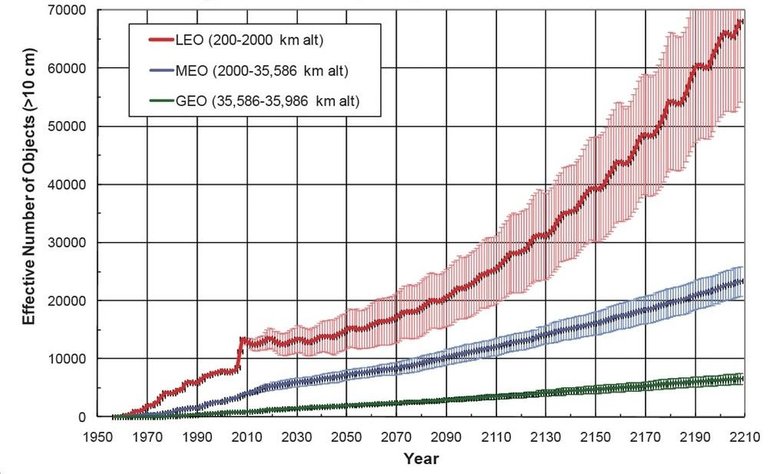
On this graph we can see simulation of space debris growth if we stop all space missions in the next 200 years without solution to remove it. [1]
Kessler's analysis lead to conclusion that amount of space debris can be classified into three categories:
- Amount of debris in orbit is low, more objects are pulled by gravitation than produced in collisions.
- More debris leads to more frequent collisions
- Debris produced in collisions is larger than destroyed leading to cascade reaction (Kessler's syndrome).
Classification
Space debris objects can be large or small. This doesn't represent physical size of the object, but current ability to detect and track them.
to Satellites | ||
|---|---|---|
| Larger than 10cm | - Can be tracked - No effective shielding | |
| Between 1cm and 10cm | - Larger objects in this range may be tracked - No effective shielding | complete destruction |
| Smaller than 1cm | -Cannot be tracked -Effective shielding exists |
The spatial distribution of space debris orbit as a function of altitude can be divided into three main regions of space, :
- Low Earth Orbit (LEO, below about 2 000 km)
- Medium Earth Orbit (MEO, between 2 000 km and about 30 000 km)
- Geostationary Orbit (GEO, above 30 000 km).
Space Debris in Low Earth Orbit
Low Earth orbit is the innermost stable orbit with altitude ranging from 160km up to 2000km. No manned mission has ever left LEO apart from Apollo mission.
Satellites in LEO use Sun-synchronous orbits. Satellites in a Sun-synchronous orbit crosses over the equator at approximately the same local time each day (and night). this is necessary for science because it keeps the angle of sunlight on the surface of the Earth as consistent as possible.
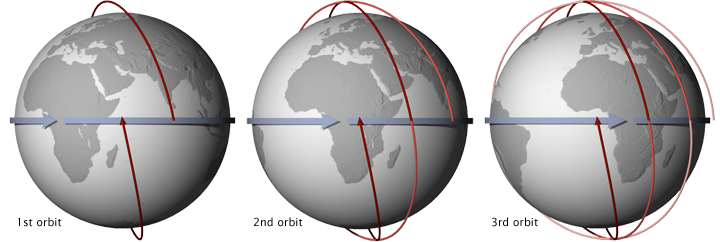
Space Debris in Geostationary Orbit
Geostationary orbit is circular geosynchronous above equator (inclination i=0º) at the altitude of 35 786km. Satellites in this orbit will always have the same position above the Earth.
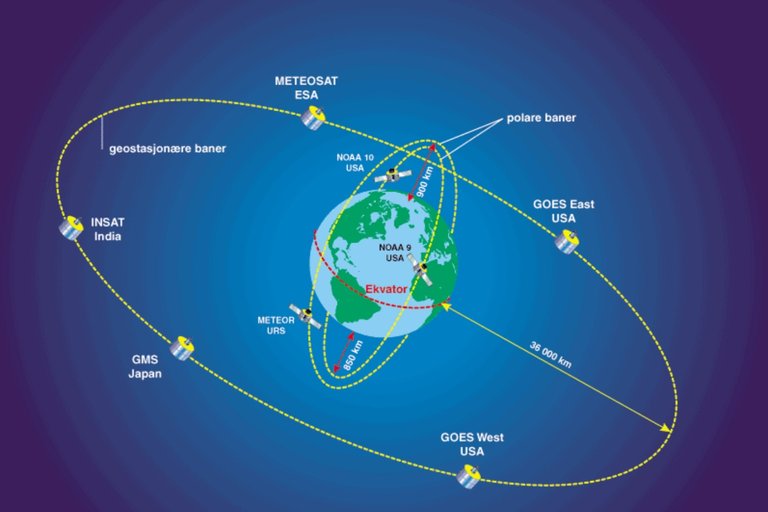
Space debris at high altitudes, where gravitation pull is neglectable, can't be destroyed in the atmosphere. This is a real threat since satellites in this orbit are sharing the same orbit.
Orbital perturbations are significant, causing longitudinal movement and orbital precession. Active satellites correct their orbits with vector thrusters, but if they fail it would cause serious problems.
Telstar 401 communication satellite lost power when it was hit by magnetic storm in 1997, on average this satellite has one close approach (less than 50m distance) a year.
In GEO debris velocities are small, but it would probably disable satellite on impact. Debris would most likely hit the large solar panels resulting in a total carnage. This scenario was nicely shown in the opening scene and few more in the "Gravity" (Not commenting the movie. :) )
To avoid collisions, safety measures are implemented - every new satellite must have the ability to move from GEO to space graveyard at the end of their mission.
Space Debris and International Space Station
International space station uses stuffed Whipple shield as protection from debris. Whipple shield was invented by Fred Whipple in 1940. Modern spacecrafts use one of the many variations.
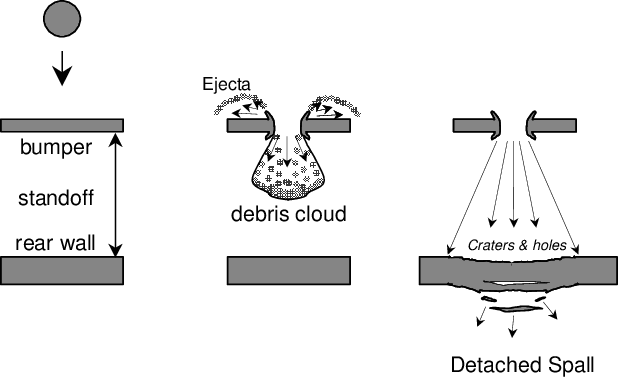
Stuffed Whipple shield is made of aluminium bumpers (front and rear wall), with nextel and kevlar layers placed in between. Front wall disperse the force of the single projectile over a larger wall area, additional layers slowing it drastically, resulting in a benign hit to the spacecraft.
These shields can only be used for spacecraft body and protection from small debris, leaving solar panels exposed.
.jpg)
Trajectory Operations Officer (TOPO) is in charge of maintaining the knowledge of where the space station and visiting vehicles areand to make sure they don't get hit by anything.
USSTRATCOM,maintains a catalog of all pieces of debris and screen three times a day the ISS trajectory versus that catalog. Last year NASA installed latest generation space debris sensor on the ISS.
Possible Solutions
There are many proposed solutions to this increasing problem, I will mention three most promising projects.
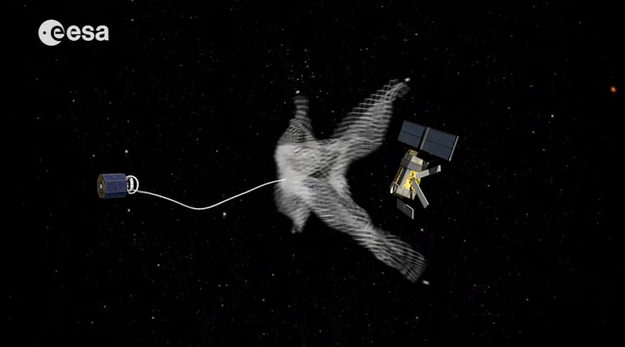
Large satellite hunter
ESA plans to launch a mission called e.Deorbit in 2023. The likeliest target of the e.Deorbit mission will be Envisat satellite, which went silent in 2012. E.Deorbit will use either a net or a robotic arm with a gripper to catch the satellite. Subsequently, it will use its own propulsion to steer into the atmosphere, where both satellites will burn up.
Laser broom
High-energy pulsed laser radiation may be the best solution to remove orbital debris in the size range of 1–10 cm. Proper direction of the impulse vector either deflects the object trajectory or forces the debris on a trajectory through the upper atmosphere, where it burns up. Drawbacks of this method is degradation of material, or hitting the functional satellite by mistake.
RemoveDEBRIS CubeSat
The mission will comprise of a main satellite platform (~100kg) that once in orbit will deploy two CubeSats as artificial debris targets to demonstrate some of the technologies (net capture, harpoon capture, vision-based navigation, dragsail de-orbitation).
The RemoveDEBRIS platform will be launched to the International Space Station (ISS) using a NanoRacks service and Space X rocket this year. The sequence of launch is described as follows. The platform is packed in specialist boxes which are launched to the ISS. The boxes are unpacked by the astronauts and installed on a slide table. The slide table moves into the ISS Japanese module and a special robotic arm grapples the platform and moves it outside the ISS. The arm then releases the platform in a very specific direction and the mission begins. [4]
Space debris has become one of the biggest problem of space exploration in Earth's orbit. We can't stop debris production, but we must take precaution measures to reduce it. Without the effective way to clean the space debris it is the matter of time when something hits one of the big satellite or endanger the human life.

Being A SteemStem Member
Cant really upvote this now but it deserves my recognition.
I love "space stuff" and reading or watching about this topic is amazing.
Amazingly written once again sir!
Thank you, barbarian! :)
Any time mr pipecleaner B-)
Hi, I found some acronyms/abbreviations in this post. This is how they expand:
Well, that's a start. If humanity doesn't remove space debris it's gonna get problematic indeed.
Thanks so much for the post. I have used this website for a long time to look at stuff in space - http://stuffin.space/. It is hard to imagine just how long we have been putting debris in space. You can click on any of the items and it will tell you what year it ended up in space. I have found some from 1972. Wow.
damn, I missed this when I could vote on it... but I have to say that was a very interesting read. I find it almost horrid, that we are littering space and treating it like we have treated our earth. With exponential growth and interest in outer space, I can foresee us fucking up shit we know nothing about. We need to clean our shit up. Loved this post